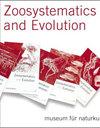A new species of terrestrial foam-nesting frog of the Adenomera simonstuarti complex (Anura, Leptodactylidae) from white-sand forests of central Amazonia, Brazil
IF 1.6
2区 生物学
Q2 ZOOLOGY
引用次数: 0
Abstract
By using integrative taxonomy, we describe a new species of terrestrial foam-nesting frog of the genus Adenomera from white-sand forests of the Rio Negro Sustainable Development Reserve, Central Amazonia, Brazil. Within the A. andreae clade, the new species belongs to the A. simonstuarti complex where it is sister to the lineage from the lower Juruá River. The new species is assigned to the genus Adenomera by having adult SVL smaller than 34.1 mm, by its lack of fringing and webbing between toes and by the absence of spines on the thumb of adult males. It differs from other Adenomera by the following combination of characters: antebrachial tubercle absent; toe tips flattened or slightly flattened, with visible expansions; nearly solid, dark-coloured stripe on underside of forearm; single-note advertisement call; notes formed by 11–21 incomplete pulses; call duration varying between 100 and 199 ms; fundamental frequency 1,765–2,239 Hz; dominant frequency 3,448–4,349 Hz; and endotrophic tadpoles with spiracle present and labial teeth absent. Over the last decade, we have inventoried many permanent sampling modules in ombrophilous forests in the Manaus Region and in the Purus-Madeira interfluve, but the new species was found only in the white-sand forest from West Negro-Solimões Interfluve. Adenomerasp. nov. may be endemic to, or at least a specialist in, this environment.巴西亚马孙河流域中部白沙森林中的一种新的陆生泡沫巢穴蛙 Adenomera simonstuarti 复合物(Anura, Leptodactylidae)。
通过综合分类法,我们描述了巴西亚马逊中部里奥内格罗可持续发展保护区白沙森林中的一种陆生泡沫巢蛙属新物种。在A. andreae支系中,新物种属于A. simonstuarti复合体,是来自Juruá河下游的姊妹种。新种的成体SVL小于34.1 mm,趾间无流苏和蹼,雄性成体拇指上无刺,因此被归入Adenomera属。它与其他 Adenomera 的区别在于以下特征组合:无前肱结节;趾尖扁平或略微扁平,有明显的扩张;前臂下侧有近乎实心的深色条纹;单音广告鸣叫;音符由 11-21 个不完整的脉冲组成;鸣叫持续时间在 100 到 199 毫秒之间;基频为 1,765-2,239 赫兹;主频为 3,448-4,349 赫兹;内养蝌蚪有螺孔,无唇齿。在过去的十年中,我们在马瑙斯地区和普鲁斯-马德拉交汇处的亲水森林中调查了许多永久性采样模块,但只在西内格罗-索利蒙斯交汇处的白沙森林中发现了这一新种。Adenomerasp.nov.可能是这种环境中的特有种,或者至少是这种环境中的专家。
本文章由计算机程序翻译,如有差异,请以英文原文为准。
求助全文
约1分钟内获得全文
求助全文
来源期刊

Zoosystematics and Evolution
ZOOLOGY-
CiteScore
3.50
自引率
5.00%
发文量
34
审稿时长
16 weeks
期刊介绍:
Zoosystematics and Evolution, formerly Mitteilungen aus dem Museum für Naturkunde in Berlin, is an international, open access, peer-reviewed life science journal devoted to whole-organism biology. It publishes original research and review articles in the field of Metazoan taxonomy, biosystematics, evolution, morphology, development and biogeography at all taxonomic levels. The journal''s scope encompasses primary information from collection-related research, taxonomic descriptions and discoveries, revisions, annotated type catalogues, aspects of the history of science, and contributions on new methods and principles of systematics. Articles whose main topic is ecology, functional anatomy, physiology, or ethology are only acceptable when of systematic or evolutionary relevance and perspective.
 求助内容:
求助内容: 应助结果提醒方式:
应助结果提醒方式:


